Signals in the crypto space are more lifesaving than indicators: from 100,000 to 20 million in 6 years, sharp rises and slow declines, continuous volume at the bottom... These 6 simple methods have beaten 90% of traders.
In the turbulent spring of 2015, I rushed into the crypto space with 100,000 in capital. At that time, looking at the candlestick chart, I thought, 'Making money isn't hard.'
As a result, I fell into two traps in two months: chasing 'hot altcoins' lost me 40,000, and bottom-fishing 'crashing coins' cost me another 30,000. When my account was down to just over 30,000, I sat in front of my computer staring blankly at the screen—turns out, making money in the crypto space isn't about 'feeling'; it's about understanding the 'language' of the market.
Later, I didn't give up and persevered for 6 years, relying on a simple method of 'watching volume, watching sentiment, watching patterns, and waiting for the opportunity' to multiply my capital by hundreds of times.
No insider information, no touching meme coins, and never studied complex indicators. Today, I share these signals earned with real money with you; even if you learn just one, it could save you hundreds of thousands in losses.
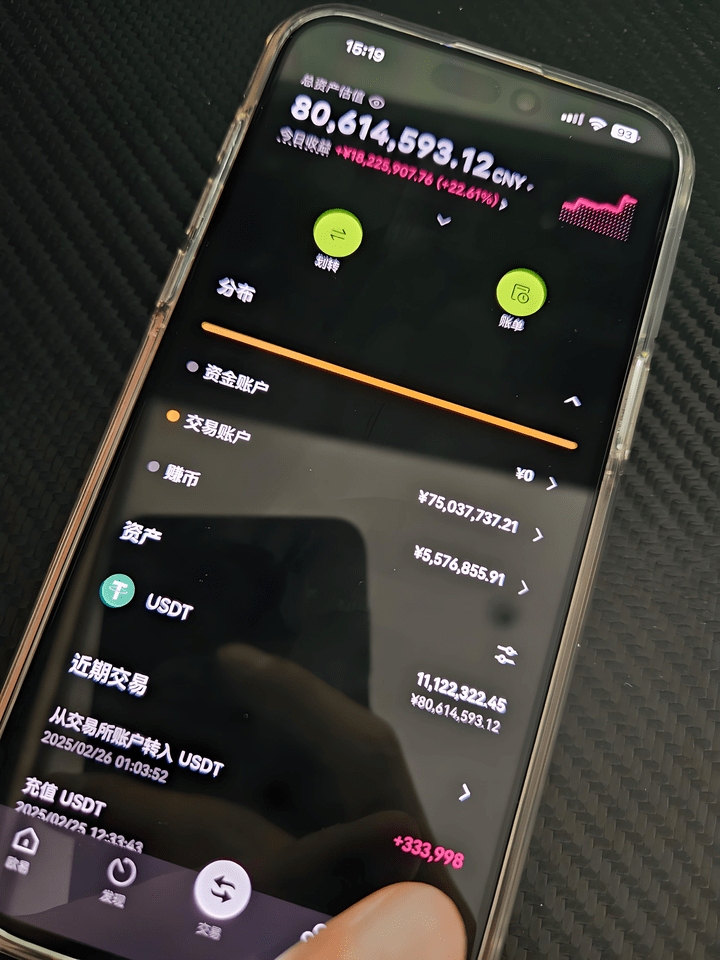
In the field of technical trading, recognizing chart patterns and price structures has always been one of the most popular methods for analyzing and trading markets. These patterns help us gain insight into the underlying order flow in the market. For traders, they assist in making buy and sell decisions. The allure of chart pattern trading is that even without relying on technical indicators, these opportunities can still be identified. Traders who have spent enough time learning these patterns often find it easier to recognize these high-probability chart patterns.
Over the years, certain chart patterns have gained a strong reputation among technical traders and are considered the most reliable and effective structural forms. This article will focus on two of these patterns: the rounding top pattern and the rounding bottom pattern. We will first introduce the rounding top pattern, explaining how to identify it on charts, what information it reveals about market direction, and how to trade based on this pattern.
Rounding top pattern
The rounding top pattern is a bearish reversal pattern. This means that the appearance of this pattern indicates that the market is likely to reverse downwards, providing traders with shorting opportunities. From this perspective, it is similar to the head and shoulders pattern. The identification of this pattern relies on a series of high points: gradually lower highs on the left, a slightly higher peak in the middle, and then again lower highs on the right, forming an overall arc structure.
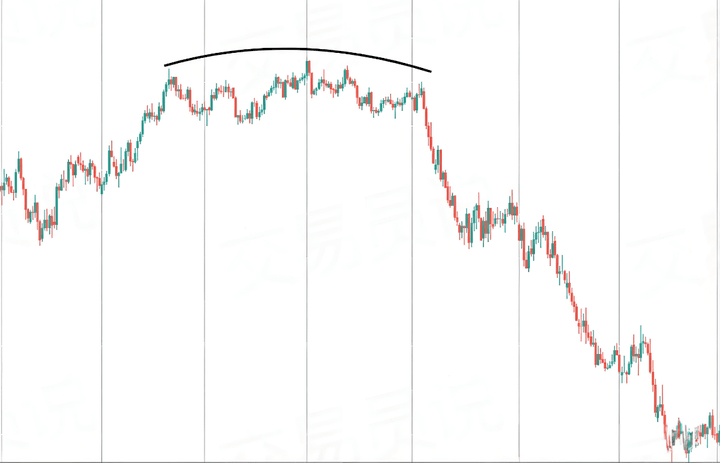
In the above chart, you can see a very typical example of a rounding top pattern. The price initially trends upward, forming the first peak on the left. Then there is a slight pullback, and the price continues to rise, entering the high point area in the middle of the arc. The price then pulls back again and attempts to rise once more. However, this time, the price fails to break through the high point in the middle of the arc, forming another lower high, allowing us to draw this arc and clearly mark the pattern.
What market signals does the rounding top pattern tell us?
Now that we know how to identify the rounding top technical pattern, you might ask, what is the significance of this? The value of the rounding top pattern lies in its ability to reveal key information about the underlying order flow within the market.
If we think about what happens in the market during the formation of this pattern, we find that initially, the bulls are in control, pushing prices up until the bears intervene and push prices lower. However, the price then encounters buying support again, pushing prices back up into the middle of the arc. Then, the bulls face strong selling pressure, causing the price to drop. Finally, the price enters the last round of buying, but the bulls can only push the price up partially, forming a lower high on the right side before the bears take control again and push the price down.
Now that we can identify the rounding top reversal pattern, we also understand the underlying order flow information that the pattern reveals. The next question is: how do we trade this pattern?
Trading rounding top patterns
According to the information conveyed by this pattern, the best way to trade it is to enter a short position when the price begins to reverse downward.
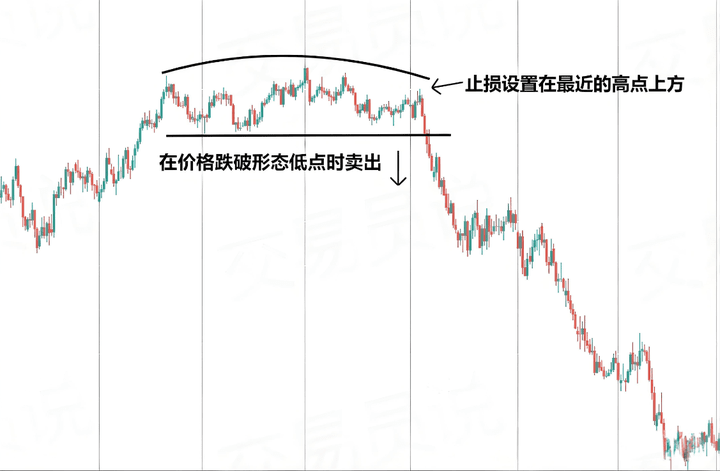
Returning to the previous example, you can see that we can draw a support line at the low point after the first peak pullback, which is essentially our trade trigger line. When the price reverses down from the final peak and breaks below this level, we can enter a sell position there. Meanwhile, we can set a protective stop-loss above the last peak of the pattern.
How to manage trades
When setting targets, as with all trading methods and strategies, the focus should always be on achieving an acceptable risk-reward ratio. That is, profitable trades must earn more than losing trades lose.
Therefore, once the stop-loss is set and the trade is entered, a simple and practical principle is to set the target price at least double the stop-loss. For example, if your stop-loss is 100 points, you should set a profit target of at least 200 points. This helps achieve more sustainable profitability in long-term trading.
Where is the best place to trade this pattern?
Considering the characteristics of this pattern, trading this structure is generally most effective after the price experiences a rise and encounters resistance (selling pressure). On the other hand, if the pattern appears during a pullback in a downtrend, it can also be useful.
One of the biggest advantages of the rounding top pattern is that once you learn to identify it, it becomes very easy to spot on the chart. As long as you can draw that arc and identify the trade trigger line, you have the right perspective. Another advantage of this pattern is that it can appear across all trading varieties and asset classes and can be used on charts of any time frame.
Next, we will delve into the explanation of the rounding bottom pattern.
Rounding bottom pattern
The rounding bottom pattern can be seen as a mirror image of the rounding top pattern. It is a bullish reversal pattern. This means that the appearance of this pattern indicates that the market may reverse upwards, providing traders with buying opportunities. From this perspective, it can be likened to the 'inverse head and shoulders pattern.'
The identification of this pattern is mainly through a series of smooth 'U' shapes or inverted arcs formed by price lows.
In other words, on the left side of the pattern, there will be an initial low, in the middle there will be a lower low, and then on the right side, there will be continuously elevated lows, completing the technical structure of the rounding bottom.
Example of a rounding bottom chart
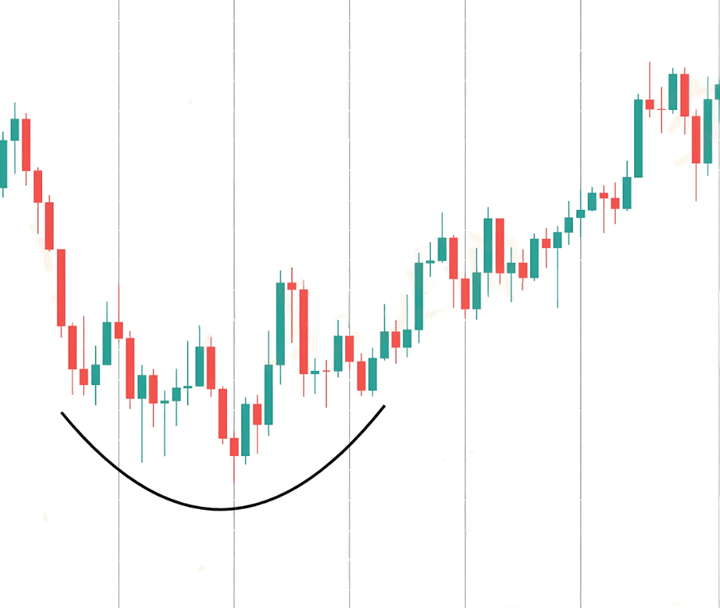
In the rounding bottom chart above, you can see a very typical rounding bottom technical pattern. The initial low appears on the left side. Then the price slightly rebounds, continues to drop, reaching the lowest point in the middle of the 'U' shape. After that, the price rebounds again, but then falls back. However, this time, the price does not make a new low but forms a higher low on the right side, thus completing the rounding bottom pattern.
What market signals does the rounding bottom pattern tell us?
The rounding bottom technical pattern indicates a shift in power between sellers and buyers in the market. If we think about the order flow within the market during the formation of this pattern, we find that initially, the sellers dominate, pushing prices down to the initial low on the left.
However, at this point, the buyers begin to intervene and push the price higher. But this upward move again encounters selling pressure, causing the price to drop further and create a new low. However, in the middle of the rounding bottom, buyers re-enter and push the price upwards. This rise also encounters selling pressure, but the strength of the sellers weakens, and the price fails to make a new low. At this time, we see a higher low on the right side of the pattern, thus completing the entire structure.
Trading rounding bottom patterns
Now that we know how to identify this pattern and understand the underlying order flow information it reveals in the market, the next question is: how should we trade the rounding bottom pattern?
Remember that a rounding top is a bearish pattern, and we would short when the price breaks down, right? This time, because the rounding bottom is a bullish pattern, we want to buy when the price breaks upwards.
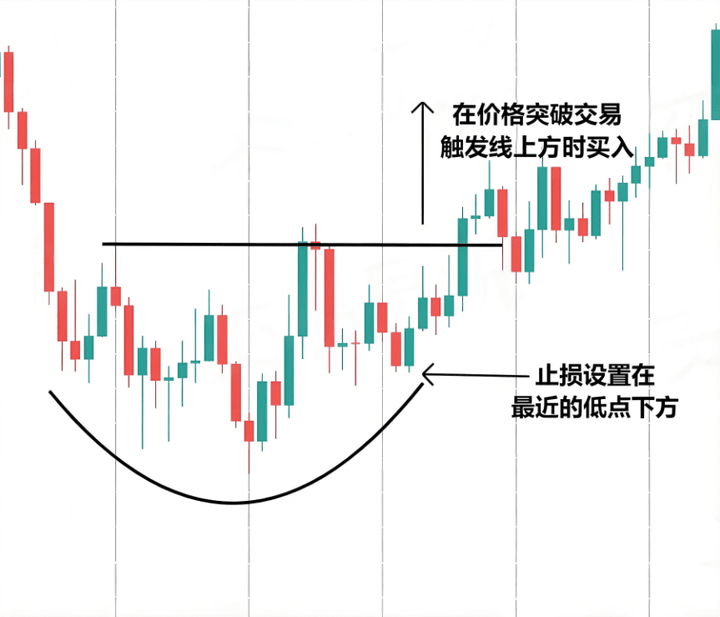
So, if we return to the previously used example of the rounding bottom pattern, let's walk through step by step how to trade this rounding bottom reversal. Similar to the rounding top, we first need to identify the trade trigger line. If we look at the initial phase of the pattern—the high formed after the first low—this high becomes our trade trigger line.
Therefore, when the price breaks through that trade line, we can choose to go long because it confirms the bullish reversal indicated by the pattern. We can then set a protective stop-loss below the last low on the right side of the pattern.
How to manage trades
Once you have entered a long position and set your protective stop-loss, it is time to consider target levels. As we discussed earlier, the best practice is to set the target level to be at least 2-3 times the stop-loss to ensure a reasonable risk-reward ratio.
If we think about the change in market sentiment during the formation of the pattern, we can imagine the market as a compressed spring. So, when the pattern is completed and the price eventually breaks through the trade trigger line, we are looking for the momentum explosion that comes from this rounding bottom breakout.
When managing trades, there are essentially two main options: the first is to set fixed target levels and exit when reached. The second is if you are a trader who prefers to hold long positions and can accept fluctuations in the market, you can move the stop-loss to breakeven after the first target is hit and continue to hold the position. This method allows you to capture greater profits when the market truly develops into a trend reversal.
Where is the best place to trade rounding bottom patterns?
Since the rounding bottom is a bullish reversal pattern, the best trading scenario is at the end of a downtrend. When the trend loses momentum or encounters strong support, recognizing the rounding bottom pattern on the chart alerts us that market sentiment may change, presenting a potential reversal opportunity. Similarly, if this pattern is identified during a pullback phase in an uptrend, it may also be a good entry point to capitalize on the main trend's recovery.
Similar to rounding top patterns, rounding bottom reversal structures can also be identified and traded on all trading varieties and asset classes across all time frame charts. As long as you can draw that 'U' shape and find the trade trigger line, you have the right perspective, and this pattern can be used for trading.
Key points to consider when trading rounding tops and rounding bottoms
As briefly mentioned at the beginning of the article, the allure of trading rounding tops and rounding bottoms lies in the fact that these patterns can only be visually identified; no technical indicators can automatically draw this pattern for you. As a technical analysis trader, you need to cultivate your ability to recognize patterns and select trading opportunities. The best advice here is to practice more.
Based on this principle, here are several key tips to keep in mind when identifying these patterns:
◎ The smoother, the better
You will notice that in the examples used to illustrate rounding tops and rounding bottoms, the price structures are quite smooth. Even the 'U' shape described by the rounding bottom resembles a gentle smile rather than a steep 'U'.
The reason is that if we think about how these patterns form in underlying order flow, we realize that essentially, it is a 'tug-of-war' for control within a certain price range. In the rounding top, power shifts from buyers to sellers; in the rounding bottom, power shifts from sellers to buyers.
Because this transformation in market sentiment is a gradual process, these patterns typically contain many small highs and lows. A smooth pattern indicates that the shift in supply and demand forces in the market is 'solid and sufficient'; thus, such patterns are more likely to be effective. If the pattern is not smooth but instead exhibits large fluctuations (i.e., high volatility), it indicates that price movements are too fierce and unstable, making such markets unsuitable for trading.
◎ Combine rounding tops and bottoms with other technical analysis methods
A key point to highlight about these patterns is that they can be used in conjunction with other technical analysis tools to enhance trading success rates. While trading solely based on pattern recognition is possible, traders can also combine other technical analysis elements, such as trend lines, support and resistance levels, and technical indicators. Integrating other technical elements is a good way to build stronger confidence in your trading approach.
◎ Pay attention to the location where the pattern appears
Finally, it is important to remember that, like all technical patterns and strategies, this pattern alone cannot guarantee success. As an excellent technical analyst and trader, your task is to study the market and identify the conditions most suitable for placing orders.
As we discussed earlier in the article, some positions are better suited for trading than others. As you practice recognizing these patterns and trading, you will gradually learn how to pick the most suitable market environments and entry positions to find the best opportunities for the specific market you are trading.
Finally, it is worth considering what advantages trading rounding tops and bottoms may have compared to other price structures and patterns.
Summary
The main advantage of rounding top reversals and rounding bottom reversals lies in their ability to catch other traders off guard. For those who haven't learned to identify this structure, it might simply look like a consolidation phase before the trend continues. However, as we've learned, the underlying order flow changes that occur during this time are crucial, and when the real reversal comes, it often carries significant force, providing great opportunities for traders.
As seen in the example, this order flow transformation accumulates energy like a compressed spring, and when a rounding top breakout or a rounding bottom breakout occurs, price movements can often release very strong momentum. Remember to set your stop-loss and targets, and always focus on achieving a good risk-reward ratio.
Finally, let me summarize and share a set of iron rules for trading cryptocurrencies:
1. Never trade out of revenge. After I finish a trade, whether profitable or not, I firmly adhere to this rule. I close the market chart and do not reopen it for 24 hours. This prevents me from making revenge trades. We close trades for a reason, meaning there is no reason to immediately re-enter. Revenge trading is a major cause of losses for emotional traders. This is especially critical when using leverage to trade Bitcoin. Cryptocurrency traders often spend many hours looking at Bitcoin prices daily, making it difficult to step away and not re-enter after a loss.
2. Avoid trading cryptocurrencies on weekends. Prices in the cryptocurrency market tend to be highly volatile and with low trading volume on weekends. This makes it difficult to predict price movements. Crypto whales can manipulate prices more easily in low liquidity, putting individual traders at a clear disadvantage. Additionally, weekends are times for relaxation and leisure; one should stay away from market charts and take a good rest.
3. Only trade during specific time periods. I can only trade when I am fully focused at my desk. The cryptocurrency market is open year-round, so we can't always keep an eye on it. I set trading periods for myself, and I only check the market during those times. This avoids the impulse to continually engage with the market and my phone, allowing me to spend time with family and do other meaningful things.
4. Never get emotionally attached to assets. If you fall in love with an asset or investment you want to trade, it can lead to poor decision-making. Trading without emotions means decisions are not influenced by subjective factors. People tend to have emotional preferences for certain altcoins, teams, or projects. This is great for investors but can be a potential disaster for traders.
5. Keep it simple and stupid. This is one of my firm rules. When I was a beginner, I would check multiple indicators, news sources, and patterns to find the optimal trading method. This often led to over-analysis; when I saw trading opportunities on the chart, understanding stop-loss and position size was far more important than timing entry and exit.
6. Only trade when in a calm state of mind. This is key. When I feel angry, tired, or stressed, I don't trade. I must be calm and focused to use my best judgment in trading. Life outside of trading is crucial for maintaining the right mindset; spending time with family and friends, reading, and participating in sports are key to my trading success.
7. Keep a journal. Journals can be boring and tedious. They are also very important because they help us avoid making the same mistakes twice. I must remind myself to slow down, stop looking at charts, and take time to record as much information about my trades as possible.
8. Simulate trading daily. I still regularly simulate trading. I simulate trading Bitcoin and some altcoins every day, which helps avoid risks and test new ideas and indicators.
9. Don't blindly chase dips. Trying to perfectly time the bottom is unwise; one should wait for safer trend change confirmation signals. Trading within a trend carries much less risk than trying to buy at lows and sell at highs.
10. Don't overtrade. I've found that the fewer times I trade, the more money I make. Even when there are many opportunities in the market, I try to keep the number of open trades to fewer than 3. Managing multiple trades is much more difficult because if each trade goes against you simultaneously, you could suffer significant losses.
The above are some of my views and insights. If you find them helpful, feel free to like and save them. I am Yan An, someone who has experienced three rounds of bull and bear markets, skilled in logical coin selection and technical timing, trading only within my cognitive range, and each direction has been validated by the market!
No matter how diligent a fisherman is, he won't go out to sea in stormy weather; instead, he will carefully protect his boat, as this season will eventually pass, and sunny days will come! Pay attention to the banquet's peace, which provides both fish and fishing skills; the crypto space's door is always open; going with the flow will lead to a smooth life—keep it in mind!

